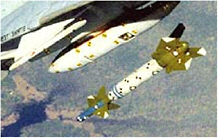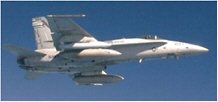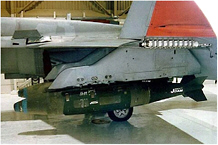7
Conventional Weapons
Since the Vietnam War significant strides have been made in improving the accuracy of both aircraft navigation systems and systems for the delivery of conventional weapons. Cruise missiles and modern aircraft delivery systems employing high technology such as improved inertial systems, laser guidance, the Global Positioning System (GPS), and television guidance have provided the ability to deliver weapons in an all-weather environment with very high accuracy. Stealth, forward-looking infrared, night-vision goggles, and GPS provided U.S. forces with the ability to operate with impunity at night, along with virtually unchallenged air superiority, in the recent Iraq war. This ability has brought us to an era in which the major limitation for aviation strike operations against hard and deeply buried targets (HDBTs) is target intelligence and the ability to penetrate and destroy HDBTs.
The emerging Global Strike Mission of the Department of Defense requires the capability to deliver rapid, extended-range, precision kinetic (nuclear and conventional) and nonkinetic weapons in support of theater and national objectives.1 This chapter briefly describes the U.S. family of non-nuclear weapons, current and under development, that support this mission. A summary of these precision-guided munitions is presented in Table 7.1.
-
The Guided Bomb Unit-28 (GBU-28) is a weapon developed for penetrating hardened, underground Iraqi command centers. The GBU-28 is a 5,000 pound, laser-guided conventional munition that uses a 4,400 pound penetrating warhead (BLU-113) containing 630 pounds of high explosives.
-
The Guided Bomb Unit-24, Advanced Unitary Penetrator (AUP), is the next-generation, hard-target penetrator munition. It shares the external appearance and flight characteristics of the 2,000 pound BLU-109 but has an advanced, heavy steel penetrator warhead filled with high-energy explosives that can penetrate more than twice as much reinforced concrete as the BLU-109. Performance is enhanced by a void-sensing hard-target smart fuze that detonates the AUP at the optimum point in a target to inflict maximum damage.
-
The BLU 118/B Thermobaric Bomb added a thermobaric explosive fill for the BLU-109 penetrator. The BLU-118/B is a penetrating warhead filled with an advanced thermobaric explosive that, when detonated, generates higher sustained blast pressures in confined spaces such as tunnels and under-
TABLE 7.1 Summary of Precision-Guided Munitions in U.S. Family of Conventional High-Explosive Weapons, Current and Under Development, That Support the Global Strike Mission
|
Weapon |
Description |
|
|
Guided Bomb Unit (GBU)-28/ EGBU-28/ BLU-113 |
Air-launched, 5,000 pound, laser-guided “bunker buster” with a 4,400 pound penetrating warhead. |
|
|
GBU-24B/D/ BLU-116 Advanced Unitary Penetrator (AUP) |
Air-launched, 2,000 pound, heavy steel penetrator warhead filled with high-energy explosives and void-sensing hard-target smart fuze that detonates the AUP at the optimum point in a target to inflict maximum damage. |
|
|
BLU-118B |
Thermobaric bomb, which added a thermobaric explosive fill for the BLU-109 penetrator. The BLU-118/B is a penetrating warhead filled with an advanced thermobaric explosive that, when detonated, generates higher sustained blast pressures in confined spaces such as tunnels and underground facilities. The BLU-118/B uses the same penetrator body as the standard BLU-109 weapon. The significant difference is the replacement of the high-explosive fill with a new thermobaric explosive that provides increased lethality in confined spaces. |
|
|
Conventional Air-Launched Cruise Missile (CALCM) Block II Penetrator |
Air-launched cruise missile with precision guidance and a 1,200 pound AUP penetrating warhead augmented with two forward shaped charges (BROACH concept) for use against buried and/or hardened targets. |
|
|
Joint Standoff Weapon (JSOW)/ Bomb Royal Ordnance Augmenting Charge (BROACH) |
Air-launched weapon incorporating the BROACH Multiple Warhead System (MWS), combining an initial penetrator charge (warhead) with a secondary follow-through bomb, supported by multi-event hard-target fuzing. Has a 500 pound class “unitary” warhead providing blast/fragmentation effects as well as enhanced penetration capability against hard targets. |
|
|
Weapon |
Description |
|
|
Tactical Missile System Penetrator (TACMS-P) |
An Advanced Concept Technology Demonstration integration of the Army Tactical Missile System (ATACMS) booster with a Navy reentry vehicle, resulting in an improved capability against buried and/or hardened targets. The TACMS-P range extends to 220 km and will be compatible with the Multiple Launch Rocket System family of launchers. |
|
|
Joint Air-to-Surface Standoff Missile (JASSM) |
Conventionally armed, low-observable cruise missile with a 1,000 pound warhead optimized for penetration; it carries a new, high-yield explosive and a hard-target smart fuze. |
|
|
Joint Direct Attack Munition (JDAM) |
The JDAM will upgrade the existing inventory of Mk-83 1,000 and Mk-84 2,000 pound general-purpose unitary bombs by integrating a guidance kit consisting of an inertial navigation system/Global Positioning System guidance kit. The 1,000 pound variant of JDAM is designated the GBU-31, and the 2,000 pound version is designated the GBU-32. Hard-target penetrators being changed into low-cost JDAMs include the 2,000 pound BLU-109 and the 1,000 pound BLU-110. |
|
|
Tactical Tomahawk Penetrator |
Tactical Tomahawk missile modified to incorporate a penetrator warhead and the hard-target smart fuze. |
|
-
ground facilities. The BLU-118/B uses the same penetrator body as the standard BLU-109 weapon. The significant difference is the replacement of the high-explosive fill with a new thermobaric explosive that provides increased lethality in confined spaces.2
-
The Conventional Air-Launched Cruise Missile (CALCM) Block II is the Precision Strike variant with guidance upgrades and a 1,200 pound AUP warhead augmented with two forward shaped charges for use against buried and/or hardened targets.
-
The Joint Standoff Weapon (JSOW)/Bomb Royal Ordnance Augmenting Charge (BROACH), a joint Navy/Air Force program, is an air-to-ground weapon designed to attack a variety of targets during day, night, and adverse weather conditions. It includes the integration of the BROACH Multiple War-
-
head System (MWS) with a 500 pound unitary warhead, providing blast/fragmentation effects as well as enhanced penetration capability against hard targets. The BROACH concept combines two forward shaped charges as part of the penetrator with a secondary follow-through bomb, supported by multi-event hard-target fuzing. The outcome is a warhead and fuze combination that provides more than twice the penetration achievable for equivalent single penetrating warhead types, at an equivalent weight and velocity. The warhead technology can be scaled and configured for a variety of weapon payload and targets requirements.
-
The Tactical Missile System Penetrator (TACMS-P) is an Advanced Concept Technology Demonstration (ACTD) program to demonstrate integration of the Army Tactical Missile System (ATACMS) booster with a Navy reentry body, resulting in an improved capability against buried and/or hardened targets. The TACMS-P range extends to 220 kilometers and will be compatible with the Multiple Launch Rocket System family of launchers. The reentry body has maneuvering capabilities for increased accuracy.
-
The Joint Air-to-Surface Standoff Missile (JASSM) is a conventionally armed, low-observable cruise missile. The missile has automatic target recognition, autonomous guidance, precision accuracy, and a 1,000 pound warhead optimized for penetration; it carries a new, high-yield explosive and a hard-target smart fuze.
-
The Joint Direct Attack Munition (JDAM) GBU-31/32, a guidance tail kit under development to meet both U.S. Air Force and Navy needs, converts existing unguided free-fall bombs into accurate, “smart munitions” for use in adverse weather. With the addition of a new tail section that contains an inertial navigational system and GPS guidance control unit, JDAM improves the accuracy of unguided, general-purpose bombs in any weather condition. The program will produce a weapon with high accuracy and an all-weather, autonomous, conventional bombing capability. JDAM will upgrade the existing inventory of general-purpose and penetrator unitary bombs, and a product improvement may add a terminal seeker to improve accuracy. JDAM can be launched from approximately 25 kilometers from the target, and each is independently targeted.
-
The Tactical Tomahawk Penetrator is a variation of the BGM-109 Tomahawk, which is an all-weather submarine or ship-launched land-attack cruise missile. After launch, a solid propellant propels the missile until a small turbofan engine takes over for the cruise portion of flight. Tomahawk is a highly survivable weapon. Its detection by radar is difficult because of the missile’s small-cross-section, low-altitude flight. Similarly, infrared detection is difficult because the turbofan engine emits little heat. Systems include a GPS receiver; an upgrade of the optical Digital Scene Matching Area Correlation (DSMAC) system; Time of Arrival (TOA) control, and improved 402 turbo engines. A modification of the Navy’s tactical Tomahawk missile is being developed that includes a penetrator warhead and the hard-target smart fuze.
NOTES
|
1. |
The U.S. Strategic Command is directed to provide capabilities established in the Nuclear Posture Review, full-spectrum global strike, and coordinated space and information operations capabilities to meet national security objectives for both deterrence and decisive action. |
|
2. |
For additional information, see section entitled “Background” in Chapter 1. |












